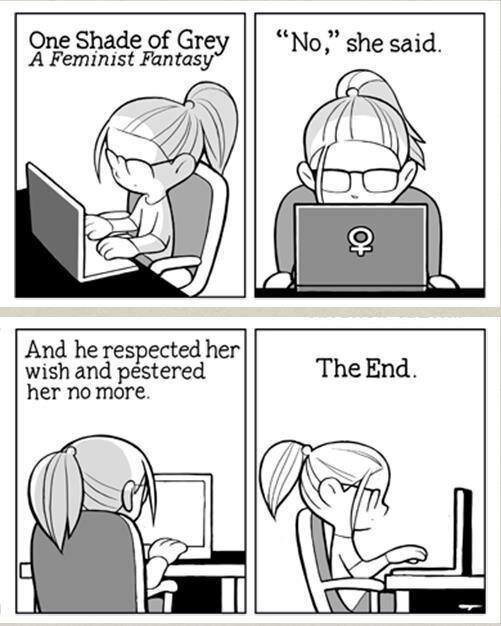Though nitrous has been used in U.S. dental offices for years, the gas delivery system for dentistry is different—it’s a continuous flow system while “the gas mixture [for labor] only flows to the patient when she holds the mask to her face and inhales,” Mike Civitello, a product sales manager at Porter Instruments, told me. “The system is controlled by the patient when she wants and needs pain relief.” This patient control also prevents a woman from getting too much nitrous; if she starts to get too drowsy from it, her hand and the mask will fall away from her face..."...
- Ben Blatt at Slate"...Of course, it's not entirely surprising that people aren't spending their free time reading encyclopedia articles on the human ankle. But in the past five years, we have searched for the
. Some fraction of these searches are surely the result of a juvenile impulse—searching Wikipedia for
is the 21st-century equivalent of looking up swear words in the dictionary. Some other fraction of the searches likely spring from a perfectly natural adolescent impulse: A desire to understand how your body works, and how the body of the opposite sex works, too.
The pages, and their histories, also offer a glimpse into Wikipedia’s awkward adolescence, and into the issues the encyclopedia continues to struggle with as something of an Internet young adult. As you might imagine, these sensitive regions of the body have inspired heated editorial debates, debates that point up the imperfections in Wikipedia’s crowd-sourced model—specifically the degree to which men outnumber women in the Wiki-editing ranks.
These debates play out in Wikipedia’s talk pages, where editors discuss changes and identify possible improvements to each entry. Since the conception of the vagina page, there have been 119 discussions threads in its talk page. The penis page, in the same timeframe, has had twice as many topics posted, with 255.
Of the 255 discussion topics on the
penis page, a fair number relate to the controversial circumcision debate. But an even larger portion are focused on whether or not there should be a photo of a penis on the
penis page, how many photos is enough, and whose photo should be chosen..."...
'What I Be' Project Reveals People's Darkest Insecurities In Stunning Photos - Slate"...Photographer
Steve Rosenfield recently asked subjects far and wide to complete the following statement: "I am not my ___ " He prompted individuals to fill in the blank with their deepest and darkest insecurities, moving people to bring issues regarding body image, substance abuse, mental illness, race and sexuality to the forefront.The results of the social experiment of sorts is a photography series titled the "
What I Be Project," an intimate examination of the anxieties and inhibitions that plague men and women of all ages. Rosenfield posed his volunteers in simple positions, adorning the subjects with bold black phrases of their choosing, written on their arms, chests and faces."
I am not my PTSD," states one woman, decorated with the words "It wasn't my fault." "
I am not my sexuality," a young man declares," shown with the word "faggot" written diagonally across his face."
The 'What I Be Project' is all about honesty," Rosenfield writes on his site. "In today’s society, we are told to look or act a certain way. If we differ from these 'standards,' we are often judged, ridiculed, and sometimes even killed over them. I started this project in hopes to open up the lines of communication, and to help everyone accept diversity with an open mind and heart."..."...
New Jewish Rituals Offer Comfort to Women Who Have Had Abortions - Josie Glausiuz at Tablet Mag"...Within the Orthodox Jewish tradition, abortion is generally permitted only when the pregnancy would endanger the life of the woman, although some authorities allow it in cases of severe genetic disorders, such as
Tay-Sachs disease. Conservative and Reform attitudes toward abortion tend to be more tolerant, allowing it in cases of severe psychological harm as well. Even so, “abortion is one of those issues that’s on the dark side of fertility,” said Elana Sztokman, executive director of the Jewish Orthodox Feminist Alliance. “People, especially in the religious Jewish community, often do not like talking about it. Even though Judaism has quite a humane approach to abortion, the Jewish community as a whole still often does not speak openly about abortion. Many women who have had abortions experience solitude and loneliness and even a fear of social judgment.”The result is that many Jewish women who choose abortion go through the ordeal alone, in silence and fear and with no spiritual recourse or guidance. While prayers for women have been composed to mark virtually every other life-changing experience—including miscarriage, infertility, and
menopause—the notion that some form of religious observance is necessary, desirable, or acceptable for abortion is hard for many people to fathom. They may believe that abortion is a procedure that the woman has chosen, often for “elective” social reasons, and not something visited upon her, as with an unintended pregnancy loss. A Jewish ritual for abortion is also complicated from a feminist point of view: Forty years after
Roe v. Wade—and decades of often-violent anti-abortion activism and restrictive state legislation—some feminists don’t necessarily want to acknowledge the notion that abortion may be associated with feelings of grief, loss, or regret that may last for years.Yet some women who have chosen abortion, even if they are sure that it is the right choice at the time, find themselves dwelling upon the decision, even years after the procedure, and often on its anniversary or in the weeks leading up to it. Immersing in the mikveh, said Mayyim Hayyim’s executive director Carrie Bornstein, can offer the woman an opportunity for separation and transition: “Oftentimes it’s helpful for people to say, ‘I’m going to move to the next stage of my life, whatever that might bring, and I’m not going to let that experience define me or take me over.’ ”..."...
The State We're In Podcast #5: Inna Shevchenko - Jonathan Groubert at TSWI"...This week in The State We’re In Podcast: Jonathan speaks with Inna Schevchenko, the leader of the radical feminist protest organization FEMEN, whose manifestations have garnered her equal measures of devotion, death threats and lawsuits..."...
Feticide Laws Advance 'Personhood,' Punish Pregnant Women - Imani Gandy at RH Reality Check"...The rush to establish “personhood” and the enthusiasm for protecting fetuses above all else has perverted the stated purpose of fetal homicide laws. Once intended to protect fetuses and provide to pregnant women and their families a legal remedy for wrongful death, fetal homicide laws are being misused by overzealous prosecutors and judges to trample women’s rights in favor of the nebulous personhood rights of fertilized eggs, embryos, and fetuses. These nebulous personhood rights even include the right of a fetus to be free from any potential harm in utero. Accordingly, women who engage in stigmatized behavior—like drug or alcohol use—are finding themselves incarcerated and arrested, charged under fetal homicide laws that were specifically not intended to criminalize their behavior or punish them.“A prosecutor on a mission can change the law just by charging until it sticks, and hoping that the court will engage in judicial activism and allow laws that explicitly say that they won’t be used against pregnant women to be used against pregnant women,” explained Diaz-Tello. Indeed,
a recent study by NAPW Executive Director Lynn Paltrow and Jeanne Flavin, a sociology professor at Fordham University, found 413 cases in which laws intended to protect fetuses have been used to arrest, prosecute, and detain women, or to force them to submit to medical intervention.Tragic cases like that of
Bei Bei Shuai, whose attempted suicide resulted in the death of her newborn daughter, illustrate the point.Shuai was charged under Indiana’s feticide statute, despite the fact that at the time of her death
her daughter Angel was not a fetus, and Indiana’s feticide statute was not intended to criminalize the behavior of pregnant women. Even though Shuai’s daughter was born and lived for several days before dying, attorneys for the State of Indiana proceeded with the case anyway, with a stamp of approval from the state judge who refused to dismiss the charges against Shuai. (Shuai
eventually plead guilty to criminal recklessness.)This perversion of laws intended to protect the rights of women and children extends beyond the fetal homicide context; criminal laws are being used to establish separate legal rights for eggs, embryos, and fetuses even in cases where state legislatures did not intend such a result..."...
I'm a Trans Woman, But Please Stop Asking Me About My Genitalia - Janet Mock at Elle"...I don’t talk about my kitty cat with my friends. It never seems to come up when we’re gabbing about
The Real Housewives or gagging over Beyonce’s “Partition” music video. But I—an unapologetic trans woman and writer—have been asked about my vagina (by people I do not know, mind you) more times than I can even recall.Outrageously, trans people’s bodies have been open for public dissection since 1952 when Christine Jorgensen became the media’s first sex change darling, and in the 60 years since Jorgensen’s headline-making path to womanhood, journalists from Barbara Walters to Katie Couric are still asking the same tired questions about our bodies.It’s stunning that legendary women have found themselves asking other women about their genitalia—in public. As I write in my upcoming memoir,
Redefining Realness: "Undergoing hormone therapy and genital reconstruction surgery are the titillating details that cisgender people love to hear." (For the uninitiated, cisgender is nomenclature for those who are not trans, and therefore less likely to experience the misalignment of their gender identity and assigned sex at birth.) But these are "deeply personal steps I took to become closer to me, and I choose to share them.”..."...
Need a solution to overstretched maternity services? Call the Midwife - Annie Francis at The Guardian"...Despite having a razor-sharp script and the sprightliest nuns this side of the Sound of Music, BBC period drama Call the Midwife might not be
NHS commissioners' first port of call for best practice in service design.Nevertheless, after a series of concerning revelations about NHS maternity services – which have led the Daily Mail to lament Britain's "Midwife Crisis" – commissioners would do well to watch closely as Call the Midwife returns to screens later this month. For despite its grimmer moments, the programme showcases a kind of relationship-based
midwifery that is in serious danger of extinction; despite evidence it is cheaper and more effective than other delivery models.In November the
National Audit Office revealed that mistakes in maternity care
account for a third of NHS negligence payouts, which have risen by an astonishing 80% in the last five years. There is a strong argument that one of the causes of this is the erosion of midwives' relationships with the women they treat. The fragmented way the system delivers care makes it harder to provide high quality midwifery services.In the decades since responsibility for midwifery passed from local authorities to the NHS, the midwife's role has been pushed out of the community and into hospital wards. This has created a service that provides staff to fill buildings rather than care for women and treats
childbirth as an illness, rather than a life experience.For the majority of women in this country childbirth is very safe, but it is unpredictable. To respond effectively and proportionately to problems in pregnancy, and especially in labour, a midwife must make an informed clinical judgment about the mother's health and wellbeing. This kind of decision is better made by a midwife who knows and understands the woman she is caring for..."...
Does Looking at the Ultrasound Before an Abortion Change Women's Minds? - Katy Waldman at Slate"...The journal
Obstetrics & Gynecology published
an important study this month: the deepest inquiry yet into whether viewing ultrasound images can influence a woman’s decision to have an abortion. True, anti-choicers have lately
shifted tactics from concern for the fetus to feigned concern for women’s health. But they’ve succeeded in getting mandatory ultrasound laws on the books in 10 states, and many
continue to promote the idea that, when a woman glimpses her little bean during a sonogram, her maternal instinct awakens and prompts her to carry the pregnancy to term.
Seven states now mandate that women seeking abortion get an ultrasound first and require doctors offer the women a chance to see the images; three states require the doctors to show and describe the ultrasound. But despite the conservative push for these laws, smaller studies out of Texas, Canada, and South Africa imply that sonogram viewings do not impact women’s decisions to end or continue their pregnancies.
This latest study is much larger. Researchers analyzed 15,575 medical records from an urban abortion care provider in Los Angeles. Each patient seeking an abortion was asked how she felt about her choice: Those who made “clear and confident” replies were rated as having “high decision certainty,” while those who seemed sad, angry, or ambivalent were said to show “medium” or “low” decision certainty. (Only 7.4 percent of the women fell into the latter categories.) Patients underwent ultrasounds as part of the standard procedure, and 42.5 percent of them opted to see the images. Of those, 98.4 percent terminated their pregnancies; 99 percent of the women who did not look at the photographs ended their pregnancies. But here’s the thing: The women who viewed the sonograms and then backed out were all part of that 7.4 percent of women with low or medium decision certainty. Women who knew abortion was the right decision for them continued with the procedure whether they were shown the images or not..."...
Vermont Introduces Bill Affirming Right to Abortion - Emily Crockett at RH Reality Check"...Vermont state senators introduced
a bill Tuesday to officially decriminalize abortion in the state and recognize a woman’s right to have an abortion.The bill, S 315, introduced by state Sens. Tim Ashe (D/P-Chittenden), Christopher Bray (D-Addison), Sally Fox (D-Chittenden), Virginia Lyons (D-Chittenden), Dick McCormack (D-Windsor), and David Zuckerman (P-Chittenden), would repeal old Vermont statutes still on the books that criminalize performing abortion or advertising about abortion services.While those statutes pre-date
Roe v. Wade and are thus unenforceable, the new bill states that repealing them would “serve as an important legislative action in support of a woman’s reproductive rights as well as help a health care provider to perform an abortion without fear of criminal liability.”..."...
She Who Tells a Story: Women Photographers from Iran and the Arab World - Kristen Gresh at MFA"...
She Who Tells a Story introduces the pioneering work of twelve leading women photographers from Iran and the Arab world: Jananne Al-Ani, Boushra Almutawakel, Gohar Dashti, Rana El Nemr, Lalla Essaydi, Shadi Ghadirian, Tanya Habjouqa, Rula Halawani, Nermine Hammam, Rania Matar, Shirin Neshat, and Newsha Tavakolian.As the Middle East has undergone unparalleled change over the past twenty years, and national and personal identities have been dismantled and rebuilt, these artists have tackled the very notion of representation with passion and power. Their provocative images, which range in style from photojournalism to staged and manipulated visions, explore themes of gender stereotypes, war and peace, and personal life, all the while confronting nostalgic Western notions about women of the Orient and exploring the complex political and social landscapes of their home regions.Enhanced with biographical and interpretive essays, and including more than 100 reproductions, this book challenges us to set aside preconceptions about this part of the world and share in the vision of a group of vibrant artists as they claim the right to tell their own stories in images of great sophistication, expressiveness, and beauty..."...


